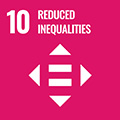- Docente: Giorgio Giovanni Negroni
- Credits: 8
- SSD: SECS-P/01
- Language: English
- Teaching Mode: Traditional lectures
- Campus: Forli
-
Corso:
Second cycle degree programme (LM) in
International relations and diplomatic affairs (cod. 6058)
Also valid for Second cycle degree programme (LM) in International Relations and Diplomatic Affairs (cod. 9247)
-
from Oct 02, 2024 to Dec 19, 2024
Learning outcomes
The aim of the course is to introduce students to the economic analysis of inequality. At the end of the course the student is able to understand and intervene with sufficient precision and autonomy in the current political/economic debate concerning: (a) the dimensions of inequality (income, opportunities, wealth) and its main measures; (b) the historical evolution of inequality (within countries, between countries and in a global perspective); (c) the different interpretations of the factors shaping inequality; (d) the relationship between poverty, inequality and growth in developing countries; (e) the role of inequality in climate change.
Course contents
The course offers an introduction to the economic analysis of inequality, both at national and global level.
The lectures will cover the following topics:
+ Concepts and measures of inequality;
+ Models of capitalism and inequality within country: functional and personal distribution;
+ From the Belle époque to present: the evolution of inequality in advanced countries and its interpretations.
+ Inequality, opportunity and meritocracy;
+ Inequality and economic development;
+ Inequality between countries and global inequality;
+ Inequality and global warming.
The detailed program will be available at the course start.
Readings/Bibliography
The bibliography will be made known at the beginning of the course.
Teaching methods
The course participates in the University’s educational experimentation project
The course is organized in lectures and seminars.
Lectures (24 hours) aim to introduce students to the core tenets of the discipline.
Seminars (16 hours) aim to provide occasions for in-depth discussions of class materials.
For the seminar section of the course, students will be divided in 8 small groups. To each group, a topic will be assigned at the beginning of the course. Each group will present the outcome of his research. Each seminar presentation lasts one hours and it is followed by one hour of discussion. Students active participation is required.
The topics covered in the seminar section will be communicated at the beginning of the course.
Assessment methods
The assessment involves two parts:
a) a group presentation of about 60 minutes (followed by discussion) on the specific topic assigned;
b) an individual written report on a general topic (identical for all students) that will be communicated 10 days before each exam call. Students have three days to write the report.
The weight of the class presentation is 0.4; the weight of the report is 0,6. The score of the group presentation is identical for all the group members. Active participation in the discussions will be rewarded.
The written report is individual. This must be understood as a sort of "technical covering report" of no more than 4 pages in which a synthetic critical assessment of the assigned topic is presented (for instance, observed trends and the possible interpretations, the main causal relationships, the aspects still unknown, …).
The student cannot refuse the mark assigned to the presentation. Instead, the student may refuse, but only once, the overall grade; in the latter case the student is granted the opportunity to rewrite the individual report once.
For non-attending students the exam will be oral and will focus on the entire program; additional readings will be required.
Teaching tools
Lectures and seminars;
Power Point handouts;
Videos;
MS TEAMS, if needed
Office hours
See the website of Giorgio Giovanni Negroni
SDGs



This teaching activity contributes to the achievement of the Sustainable Development Goals of the UN 2030 Agenda.
